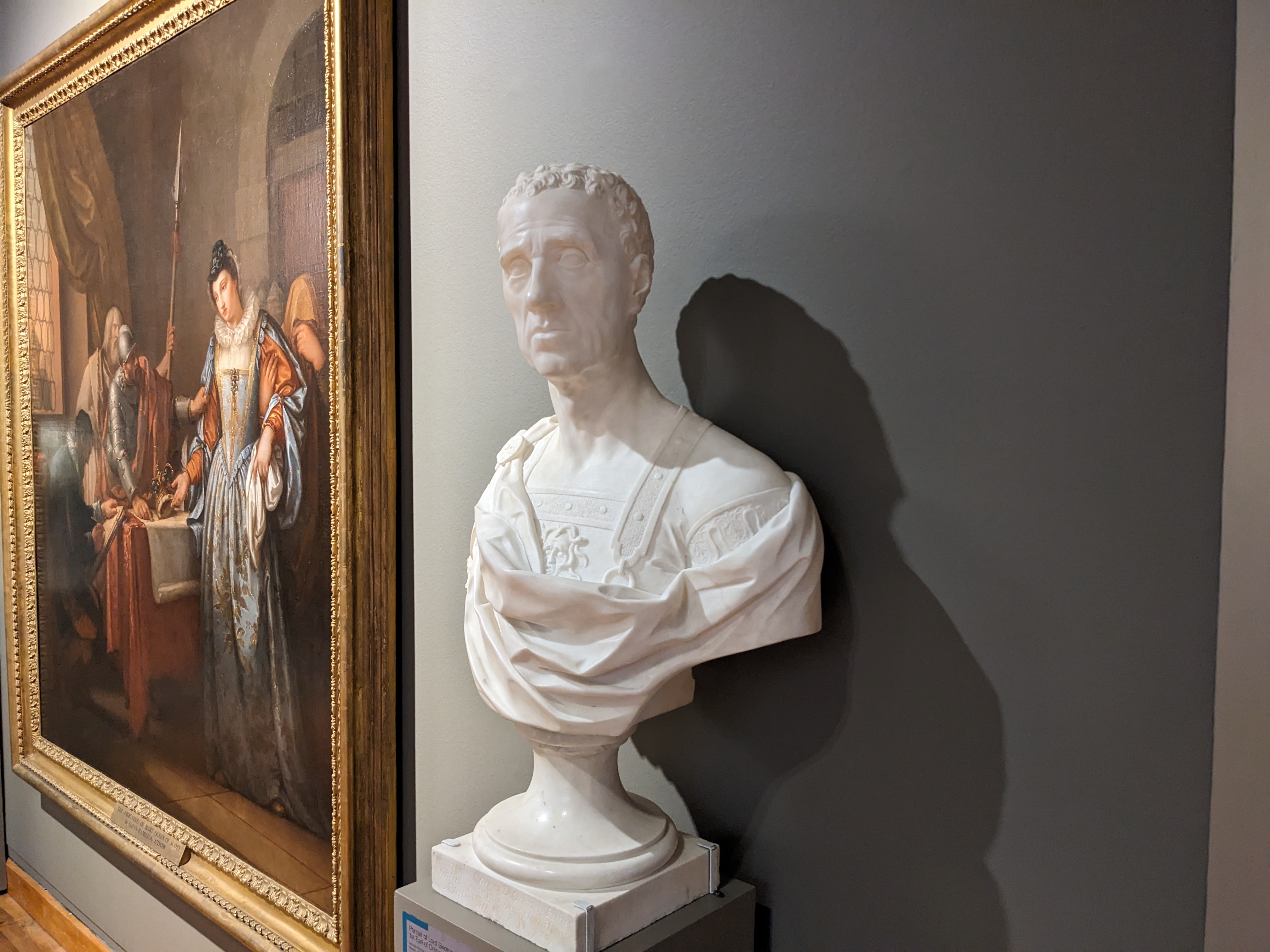The Hunterian recently added two significant 18th century white marble busts to its collection on long-term loan from private collectors. Both are on display as part of our recent reframing of our art collection. Here, we look more closely at the portrait bust of Lord George Hamilton, 1st Earl of Orkney (1666-1737) by Flemish sculptor Michael Rysbrack (1694-1770).
Rysbrack was one of the foremost sculptors and designers of his day, and at the date of this bust in 1733, the leading sculptor working in Britain.
Its inclusion in the reframing of our collection highlights the significance of sculpture in the past, and offers fresh opportunities to question historic practices.
Son of the Duke and Duchess of Hamilton, Lord George Hamilton was a distinguished army officer and a leading subordinate general under the Duke of Marlborough during the War of the Spanish Succession (1701–1714). He also served as a representative peer for Scotland in the British parliament following the Act of Union, and was a Lord of the Bedchamber to George I.
Hamilton is depicted by Rysbrack as a Roman military commander, with close-cropped curly hair and furrowed brow. The classical format adopted for this bust was the height of fashion among the political and social elites at that time.
Rysbrack and Classicism
This work by Rysbrack is now on display in The Hunterian Art Gallery, and features in Room 4 – entitled ‘History and Memory’. The objects in this room show that artists depict history and interpret the past in ways that are both controversial and far from impartial.
So, what does this bust contribute to conversations around the impartiality of artists when it comes to history? Why was the classical format fashionable at that time?
It attests to the persistence of the classical tradition in 18th century Europe, used here by Rysbrack to invite comparison between his sitter and military heroes from ancient Rome – and to suggest male heroism and strength.

The bust of Lord Orkney is an impressive example of Rysbrack’s use of classicism. Employing the classical mode of depicting the sitter was often the sculptor’s style.
It also adopts the conceit of the Roman centurion to emphasise Orkney’s role as a leading soldier in the most important recent conflict of that era, the War of the Spanish Succession. During this conflict, Orkney was the Duke of Marlborough’s most significant subordinate general.
‘Roman self-imaging’ flourished in the eighteenth century, especially in marble portrait busts, and aimed to reflect a collection of shared moral and political values of those depicted.
Despite employing the classical mode fashionable at the time, the bust cannot be described as merely formulaic. It combines classicism with aspects of the baroque in the voluminous and extravagant drapery (another characteristic of Rysbrack’s busts) that swathed the centurion’s garb.
There are other busts referring to ancient Roman portraiture in a different context in The Hunterian collections.
One of the most accomplished captures the likeness of Scottish history painter and archaeologist Gavin Hamilton (1723-1798). Hamilton spent most of his career in Rome and achieved fame as the author of huge paintings, celebrating the values of ancient Rome and Greece.

A Personal Portrait
Rysbrack’s bust of the Earl personalises Orkney’s features in an extraordinary example of authenticity – displaying the aged man’s wrinkles and even emphasising his prominent nose, a feature recorded in two-dimensional images of the soldier.
That remarkable likeness of Lord Orkney and the movement of the head give the bust a liveliness that is not seen in other busts by Rysbrack, such as the sculptor’s far more static portrait of the Duke of Marlborough.
The bust is arguably Rysbrack’s most personal portrait, as sculptor and sitter had a shared history and similar personal characteristics. Rysbrack, as a boy, witnessed Orkney marching into Antwerp at the head of an army to expel the Spanish and French garrison stationed there.
Rysbrack, from Antwerp, arrived in England around 1720, but never mastered the English language. In later life, Orkney, the son of the most important and prominent Scottish duke, Hamilton, and by then a courtier to George I and a Parliamentarian in London, implied the personal difficulties that then existed for him from having too strong a Scottish accent in the (English) capital of the unified countries of England and Scotland.
The bust is an exceptionally rare portrait of a Scot by the most important sculptor working in Britain at the time, and is arguably Rysbrack’s masterpiece in the genre of bust portraiture.
Reframing our collections
The portrait by Rysbrack is one of two 18th century marble busts recently added to our collection as loans. Both of the new additions have impeccable provenance and had earlier been on loan respectively to the Victoria and Albert Museum and the National Portrait Gallery, London.
Their owners felt that The Hunterian, as a University Museum dating back to the 18th century, would be a most suitable new home for the busts. They are particularly interested in the opportunities for fresh interpretation and study, by visitors and by students.
Looking from new perspectives, the revamped displays in our gallery rehang ask questions such as: ‘How do art and history influence each other?’ ‘What can one picture tell us?’ ‘What counts as art?’ ‘How are artworks made?’
Find out more about The Hunterian Art Gallery and plan your visit.
Stay up to date with all things Hunterian via our blog. We’ll have more features about the Art Gallery rehang in the coming weeks and months – as well as stories from right across our collections!


One response to “Lord George Hamilton, by Michael Rysbrack”
[…] Read more about the portrait bust of Lord George Hamilton, by Michael Rysbrack here. […]